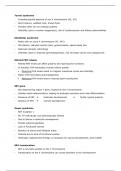Samenvatting
Summary Concept List for 'Human Development' (AB_1140)
- Instelling
- Vrije Universiteit Amsterdam (VU)
IMPORTANT concepts that you need to know for the exams of 'Human Development' (AB_1140). Writing these down and studying them helped me pass the course with a 7.
[Meer zien]




